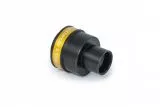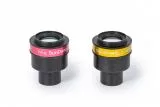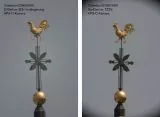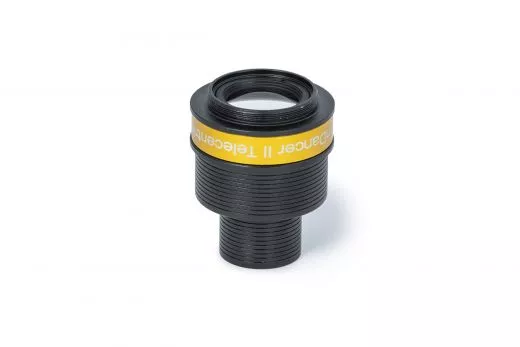- Details
- More images
Products description
Baader SunDancer II Telecentric System TZ-3S
achromatic 3x telecentricityfour-lens optics design, BBAR coating (BBAR = Broad-Band Anti-Reflection)
Anti-reflective thread and blackened lens edges to prevent reflections and for maximum contrast
Image circle 35mm at 96 mm distance to the T-2 thread base
1¼" and 2" plug-in connection with 1¼" filter thread, T-2 thread on the camera side
The designer telescopic focal point is 28 mm behind the end of the 1¼” insert sleeve
5 year guarantee if handled properly
Please note: when used as a telecentric system for H-alpha or CaK solar observation, a suitable D-ERF energy protection filter (75 - 180 mm) (various versions / variants available) must be planned in front of the telescope opening so that the lens groups can be installed the telecentric system cannot be damaged due to overheating. Heat/melt damage is not a warranty claim, but only occurs due to improper operation.
Baader SunDancer II 3x telecentric TZ-3S
Telecentric systems are mainly used with H-alpha filters for solar observation, in which the 1/100 lambda plane-parallel etalon in the H-alpha filter requires a perfectly parallel beam path across the entire image. These telecentrics deliver very sharp images, but are usually only optimized for the H-alpha wavelength.
This achromatic SunDancer 3x telecentric lens is designed for the entire visible spectrum and can therefore not only be used on H-alpha systems, but can also replace a Barlow lens. Due to the parallel beam path, it is very forgiving when it comes to the working distance: While the magnification factor of a Barlow lens changes with the distance to the eyepiece or camera (zoom eyepieces are also based on this principle), the magnification factor and image quality of the TZ-3 do not change either if the new focal point deviates very significantly from the design working distance (96 mm).
The achromatic SunDancer II TZ-3S illuminates an image field of 35mm at a distance of 96 mm from the base body, ideal for the small sensors of modern, fast planetary cameras, which require high magnifications for photographing the moon and planets. The contrast is better than with simple Barlows or the eyepiece projection that is often common for high magnifications. With the 3x telecentricity you can achieve the necessary high visual magnifications even with long focal length orthoscopic eyepieces. The eye relief of the eyepieces used does not change either.
The telescope-side connection is made via a dual 1.25"/2" receptacle with safety kerfs (these prevent tilting due to an incorrectly seated locking groove and at the same time enable a secure hold). On the camera side, the T-2 thread offers a tilt-proof, secure connection even to heavy cameras or T-2 eyepiece clamps. For the T-2 thread, extension rings are available for almost all common connection systems (e.g. M48 / 2" / M68).
A telecentric system extends the focal length in a similar way to a Barlow lens, but with a parallel beam path. This means that the working distance is almost irrelevant; the quality and image scale remain the same. At the same time, the TZ-3S delivers a high-contrast image. For the following comparison shot, a church tower was photographed with an APS-C DSLR with the same camera settings; once with a Baader Q-Barlow, which was increased to a threefold magnification factor using spacer sleeves (you can find out more about this in this PDF), and once with the TZ-3S. Edge shading is no longer a problem on cameras with an image circle of less than 35mm, and you benefit from the higher contrast of telecentricity.
The 3x telecentric system TZ-3S without block filter
The telecentricity of the Baader SunDancer II H-alpha filter (#1363056, ¤ 3545) corresponds to the Baader SunDancer II 3x telecentric TZ-3S, but also contains a 2nm (FWHM) block filter. It shimmers golden when you look into the SunDancer from the telescope side. This block filter is absolutely necessary to protect the actual H-alpha filter from solar radiation. The 3x telecentric is available as the Baader SunDancer II 3x telecentric TZ-3S without block filter, e.g. B. available for use on other H-alpha filters. The block filter, however, is not available separately.
The block filter reflects the incident sunlight just in front of the etalon and the telecentric. This protects the etalon from excessive heat. In addition, an etalon also transmits wavelengths that are multiples of the desired transmission line; these are also blocked by the block filter.
IMPORTANT NOTE
TZ systems are essential for the function of solar spectrum filters.
Please note that for H-alpha observation below 1 Ang full width at half maximum (FWHM) one absolutely needs a telecentric approach to achieve the recommended aperture ratio of f/30 to (preferably) f/40! Only with a telecentric approach can you create this perfectly parallel beam path, which is essential for the unrestricted function of such a complicated etalon.
This is a MANDATORY requirement. You could also set a telescope to an aperture ratio of f/30 optically - or using a Barlow lens - but that by no means means that this creates a parallel beam path. However, a slightly conical beam path with f/30 would only provide the contrast with an etalon with 0.5 Ang FWHM as if the filter had a pass width (FWHM) of 0.7 Ang or much worse.
It doesn't necessarily have to be a TZ-4. The new 2" Research Grade TZ-3 Telecentric System (3x focal length) (#2459257, ¤ 445) with 46mm free aperture is significantly better in terms of optics than the 20 year older TZ-4. So it makes sense that For example, you start with a TZ-3 RG and prefer to stop down the telescope aperture so that f/30 is achieved. This means that the contrast remains much better than with a poorly adapted system, where, for example, the older TZ-4 has a smaller free aperture than it does Solar Spectrum-Etalon would require. In the longer term, a newly calculated, large RG TZ-4 is in preparation - it is worth waiting for it and getting used to H-alpha observation later systems (RG-TZ-3 and RG-TZ-4) and dim the telescope opening appropriately as required.
Only AFTER the H-alpha etalon can you expand the image field size using the new ResearchGrade Telecompressor 0.4
Basically - a Barlow lens has no place in an H-alpha system!
MANUFACTURER Baader Planetarium
ITEM NUMBER (#) 1363070
EAN CODE 4047825042903
FOCAL LENGTH EXTENSION 3x
INTENDED USE Can be used for H-alpha observation as well as a Barlow lens
EXTERNAL CONNECTION (TELESCOPIC SIDE) Socket, 1¼", 2" (50.8mm)
EXTERNAL CONNECTION (EYECULAR/CAMERA SIDE) thread, T-2 (M42 x 0.75), 1.4" (35mm)
This Product was added to our catalogue on 20/05/2023.
Categories
Quick purchase
Welcome back!
Last viewed:
Manufacturer
Shipping country







